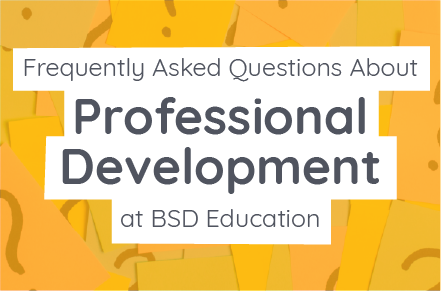At BSD Education, our Professional Development focuses on providing teachers with the confidence, skills, knowledge, and material needed to bring technology education into their classrooms. In this article, we will answer some of the most frequently asked questions by teachers worldwide.
How long does the Professional Development session last?
Every professional development session runs for three hours. By the end, teachers are prepared to bring technology and digital skills to their students. However, it’s not required for the three hours to be completed in one session, and the training can be split into two sessions of an hour and a half each.
When are BSD Professional Development sessions held?
While our sessions can be scheduled at any time, it is recommended to schedule your Professional Development sessions two to four weeks before your first class to allow enough time to explore the platform and run through the curriculum and activities for students. To schedule your BSD Professional Development sessions, please speak with your school’s BSD representative.
What are the topics covered in the BSD Professional Development?
Our Professional Development focuses on three main areas:
a) Orientation to BSD Online – This is where teachers are shown the various features of our BSD Online platform. For example, teachers are trained to create a classroom, manage student progress, and view student work through the portfolio feature.
b) Skill learning – Through our guided projects, we introduce teachers to coding languages such as HTML, CSS and JavaScript, and the basic syntax and functions of these three languages.
c) Curriculum familiarization – Teachers are shown where they can find the courses they will teach in the classroom. In addition, teachers are shown how to use the lesson plans, slide decks, and project customization guides. Through this demonstration, they better understand which activities need to be assigned to their students.
Does Professional Development need to be held in person, or can it be done virtually?
In most cases, the Professional Development will be conducted by a BSD instructor on Zoom. Training sessions are also recorded, and a copy is sent to all teachers attending to view after.
However, if a BSD instructor is available in your location, we can arrange for the session to be held in person.
What do I need to have for a BSD Professional Development Session?
All teachers need to have a laptop or desktop computer with the latest version of Google Chrome installed. Teachers also need to have an active email account sent to their BSD representative two working days before the session. The email address is used to create an account on our online platform.
I don’t have any coding or programming experience. Is this training for me?
Whether you are entirely new to using technology and coding in the classroom or have prior experience, BSD’s Professional Development has been designed with a low threshold and a high ceiling. We begin by taking small steps into the coding world and sharing tools that empower you to make the BSD Online platform your own.
Do I receive a certificate after I have completed the BSD Professional Development?
Yes! After completing the BSD Professional Development, all teachers are eligible to receive a certificate. Our team will send a PDF copy of the certificate to you by email to use professionally right away.
Does BSD leave me with any material after the Professional Development training?
We will provide you with videos and practice exercises to reinforce all the coding concepts taught during the session. All teachers will also have access to our BSD Community, where they can find articles on using the different features of the BSD Online platform.
How can I reach BSD if I have questions after the session?
Our world-class support team is always striving to provide the best support to all our teachers. You can contact them for any questions on our platform and curriculum. Here’s a link with all the details on how you can get them.
You may also reach out to your BSD representative to schedule 2 free coaching sessions per year with a BSD instructor.
What do I need to do after my Professional Development and before my first class with BSD?
Before your first class with BSD, you might be feeling excited and anxious in equal measure. You may hesitate and ask yourself, “Will it be easy to teach students using BSD?” The answer is YES!
Don’t worry; we’ve put together a handy checklist to help you get started.
——–
I hope that you found these answers helpful. If you have a question not covered in this blog post, please reach out to BSD’s Professional Development Lead in Asia, Karan Vaswani, at kv@bsd.education for more information.

